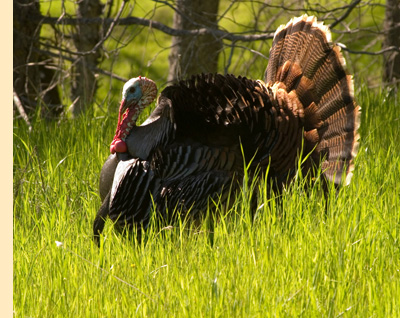
Turkey management starts with good habitat management. Turkey, like other wildlife species, have specific requirements for habitat, but may use areas that range from marginal to highly preferred. So where does your property fall on a turkey’s habitat radar? First, it is important to note that habitat requirements do vary by turkey species. Preferred wild turkey habitats for Eastern birds consists of large tracts of mature forests that range from bottomland hardwoods, mixed uplands, pine and mixed uplands, and pine forests that are interspersed with open fields. On the other hand, habitat for Rio Grande wild turkey consists of rolling plains with dense brushland to savannahs with scattered oak trees. Regardless of species, wild turkey need forested lands with some type of woody structure that is dotted with open areas that provide plant diversity for both feeding and reproduction. Sound habitat management practices should focus on habitat enhancement techniques that create or retain key structural components.
Turkey habitat can be improved through certain management practices. These management practices can include thinning of forested areas, thining of forests understory, controlled burning pine forests, planting food plots, and creating and retaining forests openings for forb and grass production. As with any land management practice, turkey managers should determine their management objectives. It is never a good idea to do something without knowing what you are trying to accomplish and habitat management can be quite expensive and timing consuming. In addition, prior to implementing any management practice, it’s a good idea to develop a comprehensive management plan for the property. Contact a wildlife professional for assistance in creating a long-term wildife and habitat management plan.
Forest management plans should consider wild turkey and other forest-dwelling wildlife species. Forests clear-cuts in upland pine forests should be limited to 50 acres or less. In addition, pine stands should have a 40+ year rotation length for long-term turkey habitat. Thinning and burning of upland pine forests is strongly recommended because turkeys are attracted to those areas because of the resulting seed-producing grasses, forbs, legumes, and insect abundance. Although turkeys need open areas, they should always be interspersed within forest lands. These grass-rich areas provide safer nesting sites because turkey predators have a more difficult time finding and destroy turkey nests. The conversion of hardwoods and large tracts of pine-hardwood forests to pine plantations is not recommended because the large-scale change could decrease local turkey populations.
When it comes to connecting wooded areas, travel corridors and streamside management zones should be maintained at least 300 feet wide in any location where clear-cutting is practiced. This is necessary to allow turkey to travel between wooded blocks. Of course, selective thinning or small clear-cuts of less than 25 acres in bottomland hardwood stands can be used to regenerate hardwood species. This is a good idea because oaks, pecan, and other mast-producing trees provide great fall food sources for turkeys and white-tailed deer. These practices will also increase woody understory plants. Dogwoods, huckleberries, blueberries, and other fruits found in the understory are good turkey foods. Management practices that promote or retain these plants should be implemented.
Once again, the importance of habitat management in turkey management should not be overlooked. Turkey management is not passive, so staying active with proper management practices is critical. Short-term habitat practices can have long-term turkey management implications.